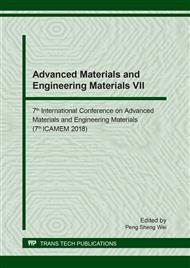p.32
p.37
p.44
p.50
p.55
p.60
p.65
p.70
p.75
Influence of Sintering Temperature on Structure and Electrical Properties of Modified-BNKT Lead-Free Piezoelectric Ceramics
Abstract:
In this research, the effects of sintering temperature on phase structure, densification, microstructure, and electrical properties of modified-BNKT ceramics were investigated. Conventional sintering of lead-free 0.97Bi0.5(Na0.80K0.20)0.5TiO3-0.03(Ba0.70Sr0.30)O3 or 0.97BNKT-0.03BSrT ceramic was investigated to clarify the optimal sintering temperature for densification and electrical properties. All ceramics were prepared by a conventional mixed oxide and sintered at various temperatures from 1100 to 1150°C. XRD pattern indicated all ceramics exhibited a single perovskite without any secondary phases. The maximum density of 5.80 g/cm3 with relative density of 99.32% were observed for the ceramic sintered at 1125°C. Grain size tended to increase with increasing the sintering temperature. The good dielectric (Td = 121 °C, Tm = 320 °C and e¢max = 4982) and ferroelectric properties (Pr = 16.66 µC/cm2, Ec = 17.85 kV/cm and Rsq = 0.74) were obtained for the ceramic sintered at optimum sintering temperature of 1125°C.
Info:
Periodical:
Pages:
55-59
Citation:
Online since:
August 2018
Authors:
Price:
Сopyright:
© 2018 Trans Tech Publications Ltd. All Rights Reserved
Share:
Citation:


